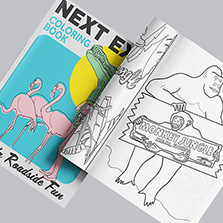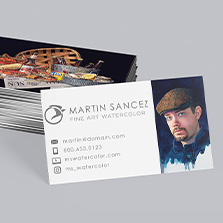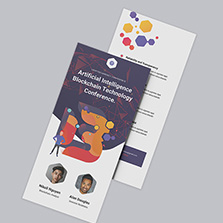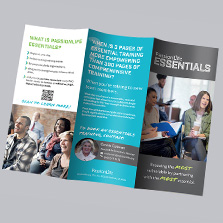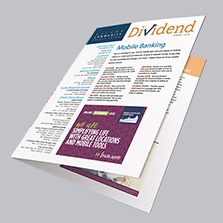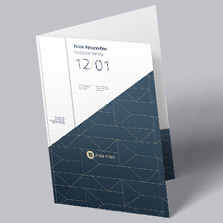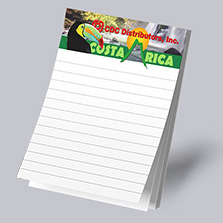
Brochure Sizes: Guide to Standard and Custom Dimensions
Size matters in all aspects of marketing, from your target audience to your marketing budget and more. So, it should come as no surprise that the size of your marketing materials also matters. Did you know brochure sizes directly impacts its design layout and readability? A small, large, or custom-size brochure will dictate the type and quantity of content on each page and the kind of reading experience your intended readers will have.
But with so many brochure sizes and folding style options, zeroing in on the best one for your project may feel overwhelming. That’s why we decided to create this guide. We’ll cover the most common brochure sizes and folds, as well as custom options available to show you that one size doesn’t fit all (brochures)!
Why Brochure Size Matters
By nature, a brochure contains much more content than other informational and marketing tools, such as a flyer. The brochure dimensions you choose will directly impact where that content goes, where you can spotlight certain content or include white space, and ultimately, the visual flow and reading experience you’ll create for your readers.
So, when designing your brochure, always keep its purpose in mind. For instance, if you plan to create a brochure to entice new customers to your company, you’ll need a size that can accommodate the content without overwhelming your potential customers.
Of course, the size you choose also affects the printing and distribution costs. Larger brochures with multiple folds and double-sided content will take more ink and other materials to create. So, you can expect the price point to be higher than a smaller brochure with standard folds and single-sided content. You’ll want to weigh all these factors as you consider the following brochure sizes.

Standard Brochure Sizes
While you can always create a brochure in any shape or size, standard brochure sizes better fit some projects or purposes than others.
Letter Size (8.5” x 11”)
The letter-size brochure, aka a general-purpose brochure, is the most common of all the standard brochure sizes, clocking in at 8.5” x 11”. They usually contain either a bi-fold or tri-fold design suitable for countless purposes, including:
- Selling products
- Detailing your services
- Introducing your company/creating brand awareness
Legal Size (8.5” x 14”)
Do you have a lot of content to include in your brochure project? Then, the legal-size brochure may fit the bill. Measuring 8.5” x 14”, this size is the perfect choice for large graphics, giving you the advantage of a two or three-panel presentation.
You’ll also have a choice of several folding styles, like:
- Bi-fold
- Tri-fold
- Z-fold
Tabloid Size (11” x 17”)
If you’re leaning toward more of an out-of-the-box brochure size, then the tabloid option could be right for you. Think of it as similar to the A3 size in Europe. With this size, you’ll have a landscape-oriented brochure suitable for large graphics or diagram spreads. Naturally, this style suits the travel and tourism industry and anyone who wants to create a product catalog.
You’ll also have a wide range of folding styles to choose from, including:
- Bi-fold
- Tri-fold
- Gate-fold
- Accordion-fold
International Sizes (A4, A5)
If you don’t fancy the above North American brochure sizes, an international size might better fit your project. International sizes are in centimeters, the most common being the A4 ( 21 cm. X 29.7 cm.) and A5 ( 14.8 cm. x 21 cm.) sizes.
The A4 is the most common brochure size used internationally. Its large pages can accommodate large graphics and swaths of text with ease. Some of the most common uses for the A4 include:
- Product catalogs
- Presentations
- Instructional purposes
- Real Estate lookbooks
- Menus
Whereas, the A5 is a smaller, bite-sized version of the A4. Its size accommodates fewer graphics and visuals. So, you wouldn’t want to choose the A5 if you plan to create a content-heavy brochure.
Different Types of Brochure Folds
Once you’ve chosen the right size for your brochure, you’ll want to focus on the folding style that will best present its contents. Each folding style below serves a different purpose depending on your design and content needs. The one you choose will affect the layout of your content and the size of the brochure you’ll end up with.

Half-Fold (8.5” x 11” or 8.5” x 14”)
The half-fold, aka bi-fold, style is a tried-and-true choice if your goal is to design a simple brochure. With this fold, the brochure folds in half in the middle, creating two same-size panels for text and graphics.
The half-fold style works best with these standard brochure sizes:
- Tabloid
- Letter
- Legal
- A3, A4, & A5
Tri-Fold (8.5″ x 11″ or A4)
As its name suggests, the tri-fold style, aka, letter fold, will give you three equal panels to lay out your content. Popular for its versatility, the tri-fold style is a go-to choice in most industries, especially restaurant and hospitality.
The tri-fold style works best with the following brochure sizes:
- Letter size
- Legal size
- A3 & A4

Z-Fold (3.5″ x 8.5″ or 10.5cm x 21cm)
Otherwise known as a zig-zag or fan-fold, the Z-fold style forms the brochure into three panels, specifically into a Z-shape. Its shape allows you to compartmentalize your content. In other words, you can spotlight specific products, services, or other important information you want to stand out to your reader.
Gate Fold (8.5″ x 11″ or A4)
If you’re looking for a unique folding style to offer your audience a unique reading experience, the gate fold is the answer. The right and left panels fold inward onto the central panel, forming a gate your readers can open. So that whatever content you’ve laid out behind the gate (e.g., a new, coveted product or large graphic, etc.) will have a greater impact on them once they reveal it.
Double Gate Brochure Fold (8.5″ x 11″, 11″ x 17″ or A4)
Unlike the gate fold style, where the right and left panels fold in once onto the center panel, the right and left panels fold in twice with the double gate fold style.
We like to think of this double gate fold as the Lady Gaga of folding styles. Its visually dramatic presentation offers even more suspense as your readers open the gates to that all-important central panel. Second, the extra panels will give you more room for detailed content.
Double Parallel Fold (8.5″ x 11″, 11” x 25.5” or A4)
Planning on designing a highly detailed brochure? The double parallel fold may work well for you. How does a double parallel fold work? The brochure is folded in half and then folded in half again, creating four sections with two parallel folds.
The double parallel fold works best with larger brochure sizes (e.g., letterhead and A4) and will give you additional panels compared to the other folding styles on this list.
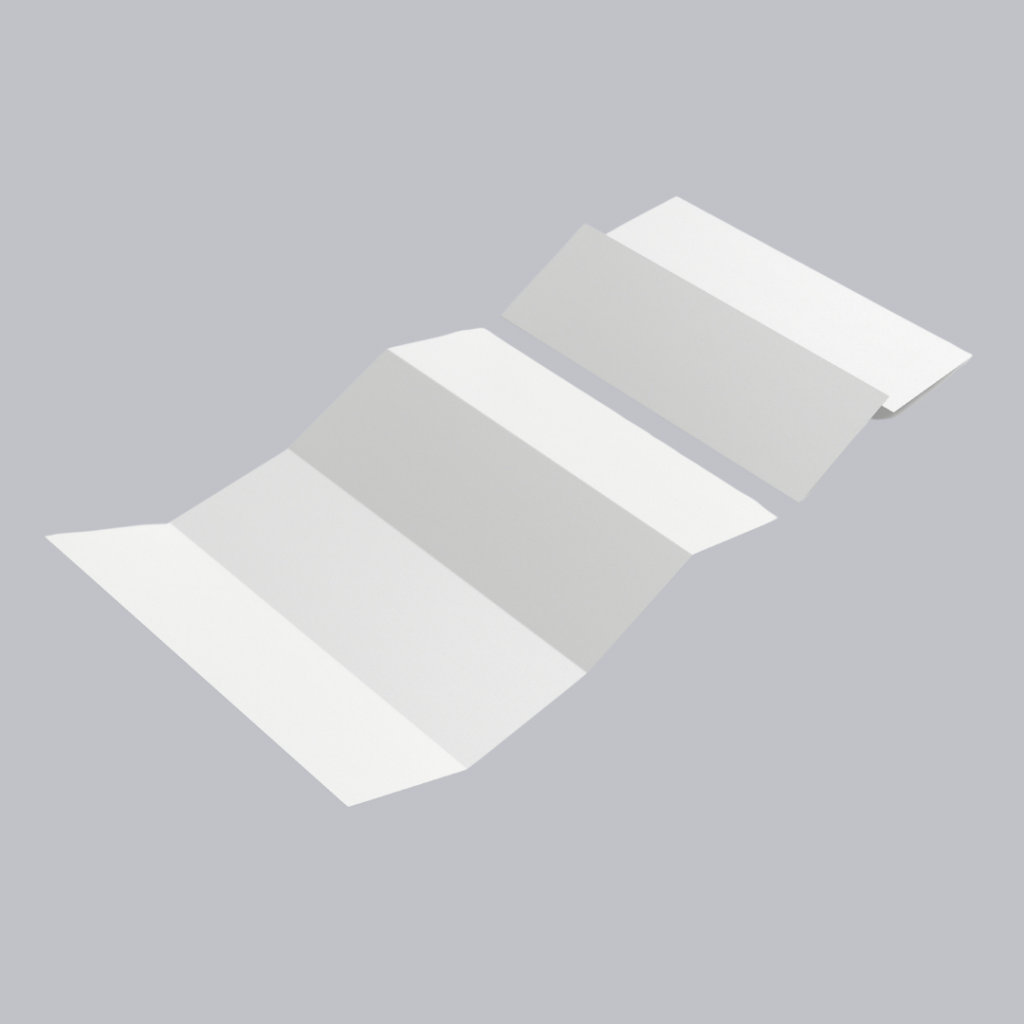
Brochure Accordion Fold (8.5″ x 11″ or A4)
Imagine an accordion with its zig-zag pattern as the musician plays it. The accordion fold bears a striking resemblance with multiple folds, each one offering a separate panel for your content.
Naturally, the accordion fold is best for longer, more detailed brochures, such as those containing maps or rendered in multiple languages.
Roll Fold (8.5″ x 11″, A3 or A4)
The roll fold, aka the over-and-over fold or the barrel fold, consists of multiple, consecutive parallel folds rolled into one another, each serving as a separate panel for your content.
This style creates a unique reading experience, allowing your content to unroll naturally. So, for example, if you plan on telling the story of your company in a brochure, the roll fold can create a rich narrative experience. It’s also ideal for compact yet content-rich brochures, such as product showcases, company profiles, and informational guides.
French Fold (8.5″ x 11″ or A4)
If you’re after a folding style with a certain je ne sais quoi, then the French fold may be your best bet. The French fold involves a combination of one vertical fold and then a horizontal fold that will yield four equal panels to work with.
This style works best with letter-size of A4-size brochures. Its unique layout is ideal for spotlighting specific products and showcasing larger graphics, especially for promotional purposes.

Exploring Custom Brochure Sizes
What if none of those standard brochure sizes measure up to your project’s standards? Designing a custom brochure is always possible! You can bring your brochure vision to life by hand-selecting the size, fold, and layout options unique to your needs.
Opting for a custom size and design will make your brochure stand out from all those standard options. As for what you might gain from a custom brochure? You’d be giving your readers a distinct and memorable glimpse into your company and what it has to offer.
Factors to Consider When Choosing Brochure Size
Narrowing down the brochure dimensions that are best for your project is anything but an arbitrary process. Consider the following factors, starting with the purpose of your brochure.
Purpose of the Brochure
What do you hope to accomplish by distributing a brochure? A higher customer acquisition rate? A better-informed clientele? Product promotion? Your size choice should reflect your purpose.
For instance, if you want to get your company’s robust product line out to your customers before the holiday season, your best bet is to choose a larger brochure that can accommodate a lot of content across multiple panels or spreads.
Amount of Content
The amount of content you need to include will dictate the amount of brochure real estate you need. Suppose you plan to include just a few images and minimal text — then, naturally, a smaller brochure size, such as a letter or half-letter size with a simple bi-fold style, may be best. Or, design a custom brochure with a size and folding style that can easily house your content.
Printing Budget
Planning to print and distribute your brochures on a budget? The larger and more complex your brochure, the more expensive printing and shipping it may be. After carefully assessing the type and quantity of content you plan to include, determine the most cost-effective way to lay it out without sacrificing your vision for the project.
Let’s do a cross comparison of different brochure sizes vs. their cost per unit. For this example, let’s assume you plan to order 500 brochures on 100 lb. paper gloss stock, full-color on both sides with a tri-fold style. And you need them in one week. Here’s what you would pay per brochure/unit:
- Letter size: $.43
- Legal size: $0.75
- Tabloid size: $0.83
Notice how the price per unit changes with all other factors remaining equal except for the size. Taking the time to weigh one size over another can make a difference for your budget.

Choosing the Right Brochure Size with PrintingCenterUSA
Nailing down just the right size and layout for your brochure will take careful planning. Start by keeping the purpose of your brochure and your target readers in mind. Also, consider the quantity of content and any budget considerations before settling on a size and folding style.
If you discover that the most common brochure sizes we’ve covered won’t work, opt for a custom size that will accommodate your needs.
Working with PrintingCenterUSA’s brochure printing services will give you access to several standard and customized size and design options for your brochure project. After all, designing a unique brochure for your brand is anything but a one-size-fits-all process!



